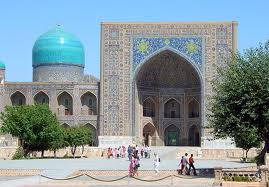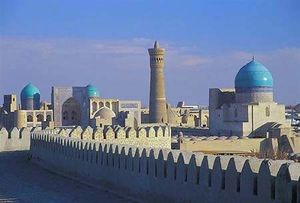Republic of Uzbekistan . Located in the heart of Central Asia, this country was once part of the Persian Empire. It has many cities where architectural monuments from various eras are located. Among them are Samarkand, Bukhara, Khiva, Shakhrizabs, Termez and Kokand. These cities were the centers of science and art. It limits to the north and northwest with Kazakhstan , to the south with Afghanistan , to the northeast with Kyrgyzstan , to the southeast with Tajikistan and to the southwest with Turkmenistan . Known for the land of cotton and vegetable gardens, entertaining bazaars and artisans, practicing their methods of trade the same way it has been done for many years.

| Form of government: | Republic |
| Capital : • Population: | Tashkent Tashkent |
| Official language: | Uzbek , Russian |
| President: | Shavkat Mirziyayev . |
| General characteristics | |
|---|---|
| Surface : | 447,400 km² km² |
| Population • Density | 32,955,400 inhabitants 74 inhabitants / km² |
| Currency : | Sum Uzbek |
| Name : | Uzbek |
| Hours : | UTC + 5 |
History

Before the gradual arrival of Turkish invaders the area was populated by Scythian elements and people of Persian and Iranian descent, who still comprise a large minority in Uzbekistan and are today called Tajiks. During the Middle Ages present-day Uzbekistan was part of the powerful Corasmian Empire. Since the Modern Age, the emirates into which the country was divided were buffer states between Persian and Chinese aspirations, and later Russian.
In the 19th century , the Russian Empire began to expand and divide Central Asia. The “Great Game” period is generally considered to be continuous from roughly 1813 to the Anglo-Russian convention of 1907 . Following the Bolshevik revolution of 1917 , a less intensive second phase followed. At the beginning of the 19th century, there were some 2,000 miles that separated British India and the remote regions of Tsarist Russia. Much of the land did not appear on maps.
At the beginning of the 20th century, Central Asia was firmly in the hands of Russia and despite some resistance to the Bolsheviks, Uzbekistan and the rest of Central Asia became part of the Soviet Union .
The 1 of September of 1991 , Uzbekistan declared independence reluctantly. While the Baltic republics led the fight for independence, the Central Asian states were afraid of it. “The centrifugal forces that broke the Union were the weakest in Central Asia. After the coup attempt in August 1991, all Central Asian leaders believed that the Union could be preserved in some way.”
Geography

Uzbekistan covers 447,400 km², an area similar to that of Morocco or Sweden . It stretches 1,425 kilometers from east to west and 930 from north to south. It borders Kazakhstan to the north, Kyrgyzstan to the east, Tajikistan to the southeast, Turkmenistan to the southwest, and Afghanistan to the south.
The Kyzyl Kum desert, which also includes Kazakhstan, occupies much of the plains in northern and central Uzbekistan. To the east of Kyzyl Kum, is the Fergana Valley, a fertile area where agricultural production is concentrated. To the east, south and north of the Fergana Valley begin the mountain ranges that separate Central Asia from China. To the west of the country lies the Ustyurt plain, a desert region inhabited by nomadic groups dedicated to pastoral activity. The country’s two main rivers are the Syr Darya and the Amu Daria, the intensive use of which to irrigate crops has contributed to the shrinking of the Aral Sea .
The mountainous regions of Uzbekistan can also be classified as one of the most beautiful landscapes in Central Asia. This picturesque place is considered by those who wish to feel the harmony of the combination with nature, withdraw from reality and think about their own life. The forests interchange with the alpine meadows, which give on the spot to the peaks raised with snow, the powerful tongues of glaciers.
Economy
The economy is based mainly on agriculture and the extraction of natural resources. Uzbekistan is a major producer and exporter of cotton, but natural gas has replaced it as the main source of foreign exchange earnings. It is also a major exporter of gold, uranium, and strategic minerals. (Uranium is Uzbekistan’s largest export to the US) Manufacturing has become increasingly important, especially in the automotive sector, which is primarily aimed at exports to the Russian market. Since independence, the government has pursued a policy of gradual transition to a free market economy, but most large companies remain state-owned or controlled.
It is difficult to accurately estimate economic growth in Uzbekistan due to reliable official statistics. Economic growth has been strong in recent years, but wealth is strictly in the hands of the elite. According to the World Bank, approximately 25% of Uzbeks live at or below the poverty line.
The government applies a strict import substitution policy to control foreign trade and prevent capital outflows. Major structural reforms are needed, especially in the area of improving the investment climate for foreign investors and liberalizing the agricultural sector. Although the government has committed itself to the theory of the provisions of (IMF) VIII, the International Monetary Fund is the article on currency convertibility for current account operations, in practice companies can wait months or even up to a year for currency conversion. convertibility restrictions, the difficulty in withdrawing local currency from bank accounts and other government measures to control economic activity, (for example, restrictions,import and export, and intermittent border closures) have limited economic growth and led international credit organizations to suspend or reverse credits.
Job
Literacy in Uzbekistan is almost universal, and workers are generally well educated and trained. Increasing corruption in the country’s education system in recent years has begun to erode Uzbekistan’s advantage in terms of human capital, degrees and titles are often bought. Furthermore, primary and secondary students in remote provinces have little access to basic education.
Most local technical and management training do not meet international business standards, but foreign companies participating in the production report hire workers locally as they learn quickly and work effectively. Uzbekistan subsidizes studies for students at the University of Westminster – one of the few Western-style educational institutions in Uzbekistan. For the 2009-2010 school year, Westminster admitted about 685 students (including graduate students). The government funded 53 students, and the university an additional 20 scholarships. Academic costs per academic year at Westminster are $ 4,900.
With many foreign companies closing or downsizing, it is relatively easy to find qualified and well-trained employees, but salaries are very low by Western standards. The government has implemented salary caps in an attempt to prevent companies from circumventing restrictions on withdrawing cash from banks. Some companies have tried in the past to evade these withdrawal limits by inflating employee wages, allowing companies to withdraw more money. These salary caps prevent many foreign companies from paying their workers as much as they would like. The labor market regulations in Uzbekistan are similar to those used in the Soviet Union, with all rights guaranteed, but disregarding some rights.
Unemployment is a persistent problem, and significant numbers of people are still looking for jobs in Russia, Kazakhstan, the Middle East and Southeast Asia. Business analysts estimate that a high number of Uzbek citizens work abroad. Estimates range from a low of 3 million to a high of 5 million Uzbek citizens of working age outside of Uzbekistan, the majority in neighboring countries or Russia. Uzbekistan signed a labor agreement with Russia in 2007 to facilitate the temporary migration of workers from Uzbekistan and the taxation of their income.
Agriculture and natural resources

Agriculture and the agro-industrial sector contribute about 18% to Uzbekistan’s GDP. Cotton is Uzbekistan’s dominant crop, accounting for about 11% of the country’s GDP in 2009. Uzbekistan also produces significant amounts of silk, wheat, fruits, and vegetables. Almost all irrigated agriculture involves heavy lifting. In 2008, the President signed a decree on the expansion of private farms, which has led to the redistribution of land from small farmers in favor of large farms.
Farmers and agricultural workers earn low wages, which the state rarely pays on a regular basis. In general, the government controls the agriculture sector, dictates what grows on farms, and sets prices for basic products such as cotton and wheat. Most of the farms growing wheat and cotton are to satisfy the state order, and farmers face the loss of their leased land if they fail to meet state quotas.
Natural resources, minerals and mining are an integral part of the economy of Uzbekistan. Natural gas is Uzbekistan’s most important source of foreign exchange, estimated at around 50% (2009). Gold is another important source of foreign exchange earnings (around 7% -10% of total exports). Uzbekistan is the world’s seventh largest producer of gold, about 80 tons per year, and maintains the fourth largest reserve in the world. It produces oil for domestic consumption and has significant reserves of copper, lead, zinc, tungsten, and uranium.
Demography
Uzbekistan is the most populous country in Central Asia. Its 25 million people, concentrated in the south and east of the country, are almost half of the total population of the region. Uzbekistan had been one of the poorest republics in the Soviet Union; a large part of its population was involved in growing cotton in small rural communities. The population continues to be strongly rural and dependent on crops for its livelihood. Uzbeks are the dominant ethnic group. Other ethnic groups include Russians 5.5%, Tajikos 5%, Koreans 4.7%, Kazakhs 3%, Karakalpakos 2.5%, and Tartars 1.5%. The nation is 88% Sunni Muslim and 9% Eastern Orthodox. Uzbek is the official state language; However, Russian is the de facto official language for inter-ethnic communication,including much of everyday use in commerce and government.
Curiosities
- It is the oldest land in Central Asia, it has more than twenty-five centuries of history, the country has a different historical and cultural community from other regions.
- The Silk Road, one of the most significant achievements in the history of world civilization, has also passed between some of these cities.
- Its cities still serve as places for religious pilgrimage, as they were for many years.
